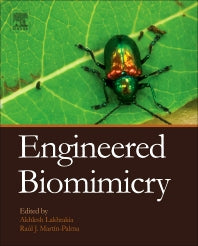Freshly Printed - allow 10 days lead
Couldn't load pickup availability
Engineered Biomimicry
This practical resource helps scientists, researchers, and engineers solve problems by mimicking ideas and concepts found in nature.
Akhlesh Lakhtakia (Edited by), Raúl José Martín-Palma (Edited by)
9780124159952
Hardback, published 2 August 2013
496 pages, Illustrated
23.4 x 19 x 3 cm, 1.17 kg
"Chemical, electrical, and mechanical engineers explain the basic process of mimicking biological systems to achieve certain goals, and illustrate them with some recent examples. Among their topics are noise exploitation and adaptation in neuromorphic sensors, biomimetic robotics, surface modification for bio-compatibility, biomimetic anti-reflection surfaces…" --Reference and Research Book News, October 2013
Engineered Biomimicry covers a broad range of research topics in the emerging discipline of biomimicry. Biologically inspired science and technology, using the principles of math and physics, has led to the development of products as ubiquitous as Velcro™ (modeled after the spiny hooks on plant seeds and fruits). Readers will learn to take ideas and concepts like this from nature, implement them in research, and understand and explain diverse phenomena and their related functions. From bioinspired computing and medical products to biomimetic applications like artificial muscles, MEMS, textiles and vision sensors, Engineered Biomimicry explores a wide range of technologies informed by living natural systems. Engineered Biomimicry helps physicists, engineers and material scientists seek solutions in nature to the most pressing technical problems of our times, while providing a solid understanding of the important role of biophysics. Some physical applications include adhesion superhydrophobicity and self-cleaning, structural coloration, photonic devices, biomaterials and composite materials, sensor systems, robotics and locomotion, and ultra-lightweight structures.
Chapter 1: Biomimetic Vision Seniors Chapter 2: Noise Exploitation and Adaptation in Neuromorphic Sensors Chapter 3: Biomimetic Hard Materials Chapter 4: Biomimetic Robots Chapter 5: Bioinspired and Biomimetic Microflyers Chapter 6: Muscular Biopolymers Chapter 7: Bioscaffolds: Fabrication and Performance Chapter 8: Surface Modification for Biocompatibility Chapter 9: Flight Control Using Biomimetic Optical Sensors Chapter 10: Biomimetic Textiles Chapter 11: Structural Colors Chapter 12: Biomimetic Antireflection Surfaces Chapter 13: Biomimetic Self-Organization and Self-Healing Chapter 14: Solution-Based Techniques for Biomimetic and Bioreplication Chapter 15: Vapor-Deposition Techniques Chapter 16: Atomic Layer Deposition for Biomimicry Chapter 17: Evolutionary Computation and Genetic Programming
Subject Areas: Materials science [TGM], Biotechnology [TCB], Biochemistry [PSB], Plasma physics [PHFP]


